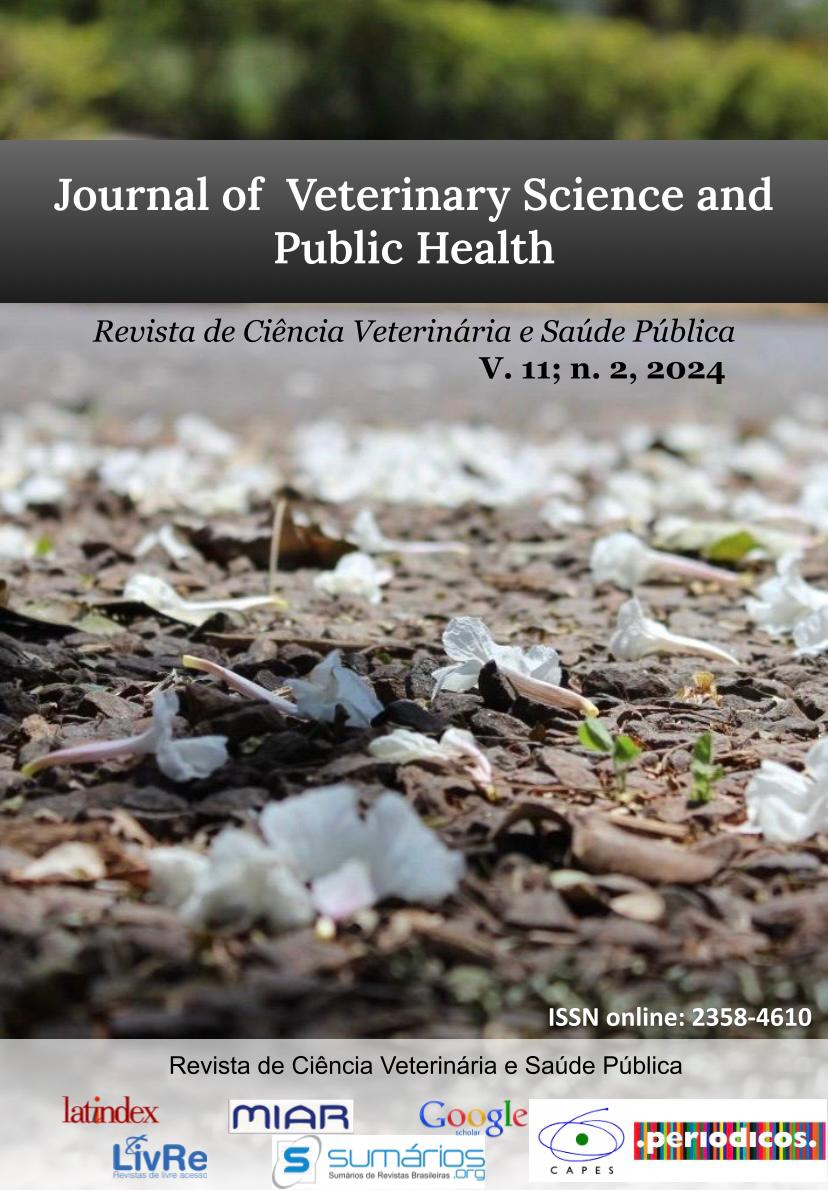FIRST RECORD OF Amblyomma ovale PARASITIZING HUMAN IN CENTRAL RIO GRANDE DO SUL, BRAZIL
Resumen
Ticks are one of the most important groups of infectious disease vectors for animals and humans, being responsible for the transmission of pathogens such as bacteria and protozoa, in addition to causing injuries to their hosts during hematophagy. However, there are few cases of parasitism by these ticks in humans in Brazil. Therefore, the objective was to report for the first time the parasitism by Amblyomma ovale (Koch, 1844) in humans in the central region of Rio Grande do Sul, Brazil, in order to alert the population about the risk of infection by pathogens including zoonoses. Therefore, a specimen of ectoparasite found in a woman residing in the city of Santa Maria, Rio Grande do Sul, was sent to the Laboratory of Veterinary Parasitology of the Federal University of Santa Maria for taxonomic identification at the species level. The tick was taxonomically classified as an adult male of A. ovale, concluding that the vector is present in the studied locality and can parasitize humans.
Descargas
Citas
DANTAS-TORRES, F.; MARTINS, T.F.; MUÑOZ-LEAL, S.; ONOFRIO, V.C.; BARROS-BATTESTI, D.M. Ticks (Ixodida: Argasidae, Ixodidae) of Brazil: Updated species checklist and taxonomic keys. Ticks and Tick-borne Diseases, v.10, p.101252, 2019.
EVANGELISTA, L.S.M.; OLIVEIRA, A.L.; GOMES, N.R.S.; OLIVEIRA, N.M.S.; SOUSA, L.S.; PEREIRA, A.D.V. Amblyomma spp. e a relação com a febre maculosa brasileira. Veterinária e Zootecnia, v.28, p.001-015, 2021.
HAYES, S.F.; BURGDORFER, W. Reactivation of Rickettsia rickettsii in Dermacentor andersoni ticks: an ultrastructural analysis. Infection and Immunity, v.37, p.779–785, 1982.
HORTA, M.C.; LABRUNA, M.B.; SANGIONI, L.A.; VIANNA, M.C.B.; GENNARI, S.M., GALVÃO, M.A.M.; MAFRA, C.L.; VIDOTTO, O.; SCHUMAKER, T.T.S.; WALKER, D.H. Prevalence of antibodies to Spotted Fever Group Rickettsiae in humans and domestic animals in a Brazilian Spotted Fever-Endemic area in the State of São Paulo, Brazil: Serologic evidence for infection by Rickettsia rickettsii and another spotted fever group Rickettsia. American Journal of Tropical Medicine and Hygiene, v.71, p.93-97, 2004.
JAGUEZESKI, A.M.; LAVINA, M.S.; ORSOLIN, V.; SILVA, A.S. Amblyomma ovale parasitizing a human. Comparative Clinical Pathology, v.27, p. 535–537, 2017.
KRAWCZAK, F.S.; AGOSTINHO, W.C.; POLO, G.; MORAES-FILHO, J.; LABRUNA, M.B. Comparative evaluation of Amblyomma ovale ticks infected and noninfected by Rickettsia sp. strain Atlantic rainforest, the agent of an emerging rickettsiosis in Brazil. Ticks and Tick-borne Diseases, v.7, p,502–507, 2016.
LABRUNA, M.B.; JORGE, R.S.; SANA, D.A.; JÁCOMO, A.A.A.; KASHIVAKURA, C.K.; FURTADO, M.M.; FERRO, C.; PEREZ, S.A.; SILVEIRA, L.; SANTOS JÚNIOR, T.S.; MARQUES, S.R.; MORATO, R.G.; NAVA, A.; ADANIA, C.H.; TEIXEIRA, R.H.F.; GOMES, A.A.B.; CONFORTI, V.A.; AZEVEDO, F.C.C.; PRADA, C.S.; SILVA, J.C.R.; BATISTA, A.F.; MARVULO, M.F.V.; MORATO, R.L.G.; ALHO, C.J.R.; PINTER, A.; FERREIRA, P.M.; FERREIRA, F.; BARROS-BATTESTI, D.M. Ticks (Acari: Ixodida) on wild carnivores in Brazil. Experimental and Applied Acarology, v.36, p.149-163, 2005.
MASSARD, C.L.; FONSECA, A.H. Carrapatos e doenças transmitidas comuns ao homem e aos animais. A Hora Veterinária, v.35, p.15-23, 2004.
MEDEIROS, A.P.; DE SOUZA, A.P.; DE MOURA, A.B.; LAVINA, M.S.; BELATTO, V.; SARTOR, A.A.; NIERI-BASTOS, F.A.; RICHTZENHAIN, L.J.; LABRUNA, M.B. Spotted fever group Rickettsia infecting ticks (Acari: Ixodidae) in the state of Santa Catarina, Brazil. Memórias do Instituto Oswaldo Cruz, v.106, p.926–930, 2011.
RECK, J.; SOUZA, U.; SOUZA, G.; KIELING, E.; DALL'AGNOL, B.; WEBSTER, A.; MICHEL, T.; DOYLE, R.; MARTINS, T.F.; LABRUNA, M.B.; MARKS, F.; OTT, R.; MARTINS, J.R. Records of ticks on humans in Rio Grande do Sul state, Brazil. Ticks and Tick-borne Diseases, v.9, p.1296-1301, 2018.
RIO GRANDE DO SUL, SECRETARIA ESTADUAL DA SAÚDE, CENTRO ESTADUAL DE VIGILÂNCIA EM SAÚDE. Guia de Vigilância Acaralógica: vetores e hospedeiros da febre maculosa e outras riquetsioses no Rio Grande do Sul. Porto Alegre: CEVS/RS, 2018. 114p.
SABATINI, G.S.; PINTER, A.; NIERI-BASTOS, F.; MARCILI, A.; LABRUNA, M.B. Survey of ticks (Acari: Ixodidae) and their Rickettsia in an Atlantic rainforest reserve in the State of São Paulo, Brazil. Journal of Medical Entomology, v.47, 913–916, 2010.
SZABÓ, M.P.J.; NIERI-BASTOS, F.A.; SPOLIDORIO, M.G.; MARTINS, T.F.; BARBIERI, A.M.; LABRUNA, M.B. In vitro isolation from Amblyomma ovale (Acari: Ixodidae) and ecological aspects of the Atlantic rainforest Rickettsia, the causative agent of a novel spotted fever rickettsiosis in Brazil. Parasitology, v.140, p. 719–728, 2013.
VIEIRA, A.M.L.; SOUZA, C.E.; LABRUNA, M.B.; MAYO, R.C.; SOUZA, S.S.L.; CAMARGO-NEVES, V.L.F. Manual de Vigilância Acarológica do Estado de São Paulo. 1th ed. São Paulo: SUCEN, 2004. 60p.
VOIZZONI, V.F.; SILVA, A.B.; CARDOSO, K.M.; SANTOS, F.B.; STENZEL, B.; AMORIM, M.; DE OLIVEIRA, S.V.; GAZETA, G.S. Genetic identification of Rickettsia sp. strain Atlantic rainforest in an endemic area of a mild spotted fever in Rio Grande do Sul state, Southern Brazil. Acta Tropica, v.162, p. 142–145, 2016.








